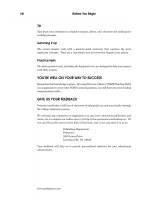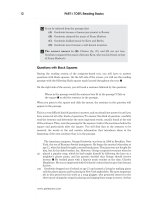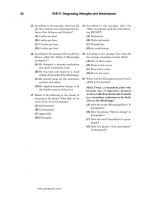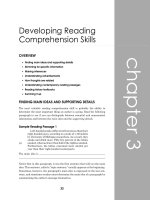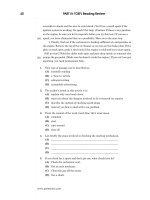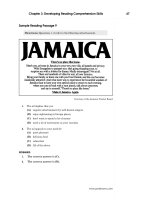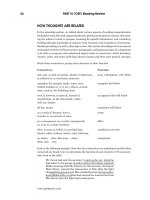Peterson’s master toefl reading skills part 6 ppsx
Bạn đang xem bản rút gọn của tài liệu. Xem và tải ngay bản đầy đủ của tài liệu tại đây (76.22 KB, 7 trang )
26 PART II: Diagnosing Strengths and Weaknesses
www.petersons.com
45. According to the passage, how fast did
the New Orleans travel downstream be-
tween New Orleans and Natchez?
(A) 3 miles per hour
(B) 8 miles per hour
(C) 13 miles per hour
(D) 18 miles per hour
46. According to the passage why was Henry
Shreve called the “father of Mississippi
navigation”?
(A) He designed a steering mechanism
that other steamboats used.
(B) He was born and raised in a small
village on the banks of the Mississippi.
(C) He printed maps for the steamboat
captains and pilots.
(D) He adapted steamboat design to fit
the shallow waters of the river.
47. Which of the following is the closest in
meaning to the phrase “from then on” as
used in line 33 in the passage?
(A) Subsequently
(B) Consequently
(C) Apparently
(D) Thoroughly
48. According to the passage, after the
1830s, steamboats had all of the follow-
ing EXCEPT:
(A) Orchestras
(B) Chefs and maids
(C) Chandeliers
(D) Air conditioning
49. According to the passage, how long did
the average steamboat remain afloat?
(A) Two to three years
(B) Three to four years
(C) Four to five years
(D) Five to six years
50. Where can the following sentence best be
added to the passage?
Mark Twain, a steamboat pilot who
became one of America’s greatest
writers, told about his brother’s death
in a steamboat explosion in his book
Life on the Mississippi.
(A) After the words “Mississippi River” in
paragraph 2
(B) After the phrase “Shreve’s design” in
paragraph 3
(C) After the word “chandeliers” in para-
graph 4
(D) After the phrase “their passengers”
in paragraph 5
02_TOEFL Reading Ch 2,15-28 7/29/06, 11:4926
Chapter 2: Practice Test 1: Diagnostic 27
www.petersons.com
answers
diagnostic test
ANSWER KEY AND EXPLANATIONS
1. A 11. B 21. C 31. C 41. D
2. B 12. C 22. B 32. B 42. B
3. A 13. B 23. B 33. C 43. C
4. B 14. B 24. A 34. B 44. D
5. C 15. D 25. D 35. A 45. B
6. D 16. C 26. A 36. A 46. D
7. B 17. B 27. D 37. B 47. A
8. A 18. A 28. C 38. C 48. D
9. A 19. B 29. B 39. D 49. C
10. B 20. A 30. A 40. D 50. D
1. The correct answer is (A). The other
choices are incorrect definitions.
2. The correct answer is (B). The answer
is stated in the first paragraph.
3. The correct answer is (A). The other
answer choices do not relate to the mean-
ing of the word.
4. The correct answer is (B). The answer
is stated in the second paragraph.
5. The correct answer is (C). The answer
is stated in the second paragraph.
6. The correct answer is (D). Choice (D)
can be inferred from the final two sen-
tences in the passage. There is nothing in
the passage to indicate the educational
level of cabildos, so choice (A) cannot be
inferred. The work of cabildos was im-
portant, so there is no basis to consider
that only “some” cabildos were impor-
tant. Choice (C) is directly stated in the
third paragraph.
7. The correct answer is (B). A police
officer keeps the peace.
8. The correct answer is (A). Only choice
(A) makes sense and is general enough in
the context of the sentence. Choice (B)
does not make sense. Choices (C) and (D)
are only two of the various responsibili-
ties that cabildos might be in charge of.
9. The correct answer is (A). It is NOT
true. Sentence 2 in the fourth paragraph
disproves this answer.
10. The correct answer is (B). Paragraph
2 describes the functioning of cabildos, so
it is the best place to add a sentence that
provides more details about this aspect.
Choice (A), paragraph 1, discusses the
background of cabildos, not their func-
tions. Inserting the sentence into para-
graphs 3 or 4 would interrupt the flow of
ideas in either paragraph.
11. The correct answer is (B). Fascinat-
ing means to hold the attention of some-
one by being interesting. Fabulous means
hard to believe or incredible. Neither
choices (A) or (D) are correct definitions.
12. The correct answer is (C). The answer
is stated in the first paragraph.
13. The correct answer is (B).
14. The correct answer is (B). Omit the
phrase “according to legend” and it is
easier to see that the antecedent is game.
15. The correct answer is (D). Sentence 2
of the first paragraph states that Oakley
02_TOEFL Reading Ch 2,15-28 7/29/06, 11:4927
28 PART II: Diagnosing Strengths and Weaknesses
www.petersons.com
was born in 1860. The final sentence in
the paragraph states both that she was
15 when she worked with Butler and
that she married him a year later. Add 15
plus 1 to find that she was 16 when she
married Butler. Sixteen plus 1860 equals
1876 when they married.
16. The correct answer is (C). It is not
true. Choice (A) can be inferred from the
third paragraph. Choice (B) is stated in
the first paragraph. Choice (D) is stated
in the second paragraph.
17. The correct answer is (B). Substitute
the answers into the sentence and an-
swer (B) makes the most sense in con-
text.
18. The correct answer is (A). The sen-
tence sums up Oakley’s life. If it were
inserted in any of the other choices, it
would not make sense because it would
interrupt the description of what she did
in her life.
19. The correct answer is (B). The answer
is stated in the fourth paragraph.
20. The correct answer is (A). There is no
information in the passage to support
either choices (B) or (D). Choice (C) is
contradicted in the fourth paragraph.
21. The correct answer is (C). Only choice
(C) includes both Eagan’s education and
athletic ability. Choice (A) is not sup-
ported by information in the passage.
Choices (B) and (D) are misreadings of
the passage.
22. The correct answer is (B). The answer
is stated in the second paragraph.
23. The correct answer is (B). The answer
is stated in the first paragraph.
24. The correct answer is (A). Eliminate
choice (D) immediately because Eagan
served in World War I.
25. The correct answer is (D). It is NOT
true. Paragraph 3 states that Eagan did
not win this medal.
26. The correct answer is (A). The an-
swer is stated in the third paragraph.
27. The correct answer is (D). Adding the
sentence to the end of paragraph 4 picks
up and adds to the information in the
preceding sentence. There is no refer-
ence to athletics in the first paragraph,
so adding the sentence there makes no
sense. The sentence would interrupt the
sense of the paragraphs if added where
either choice (B) or (C) indicate.
28. The correct answer is (C). The answer
is stated at the end of the sentence.
29. The correct answer is (B). The answer
is stated in the fourth paragraph.
30. The correct answer is (A). The answer
is stated in the first sentence of the fourth
paragraph.
31. The correct answer is (C). The First
Folio had twice as many plays as had
been printed previously and the inclu-
sion of the two actors in the publishing
team implies that good texts were used.
Choice (B) is stated in the first para-
graph and the question asks for an infer-
ence. There is no information to support
either choices (A) or (D).
32. The correct answer is (B). The other
answer choices are incorrect definitions.
33. The correct answer is (C). Statements
in the second and third paragraphs sup-
port this answer.
34. The correct answer is (B). The other
answer choices are incorrect.
35. The correct answer is (A). The answer
is stated in the final sentence of the
second paragraph.
36. The correct answer is (A). To publish
means to issue books, whereas to print
means to imprint letters onto paper.
[Very fine distinction and difficult
for an ELL person to figure out from
the context which uses both publish
and print in the same sentence.]
02_TOEFL Reading Ch 2,15-28 7/29/06, 11:4928
Chapter 2: Practice Test 1: Diagnostic 29
www.petersons.com
answers
diagnostic test
37. The correct answer is (B). The answer
is stated in the third paragraph.
38. The correct answer is (C). The answer
is supported by sentence 1 of the third
paragraph.
39. The correct answer is (D). It is NOT
true. Paragraph 4 supports this answer
as being not true, but correct.
40. The correct answer is (D). The word
“they” is a clue to the best place to insert
this sentence. The antecedent for choice
(A) is “folio edition,” which is singular.
The antecedent for choice (B) is singular,
“formality,” which also does not make
sense. The antecedent for choice (C) is
Romeo and Juliet, which is also singular.
Only choice (D) provides a plural ante-
cedent “1,000 copies” and also makes
sense.
41. The correct answer is (D). The first
paragraph supports this inference. Also,
mention is not made in the passage of the
other areas.
42. The correct answer is (B). The other
answer choices use some form of the
word tributary, but only choice (B) is
correct. Choice (A) refers to tribute, choice
(C) refers to tricycle, and choice (D) refers
to tri-state.
43. The correct answer is (C). The refer-
ence in lines 17–18 to “regular steam-
boat service” supports this answer.
44. The correct answer is (D). Substitute
the answer choices into the sentence and
the only one that makes sense is choice
(D).
45. The correct answer is (B). The answer
is stated in the second paragraph.
46. The correct answer is (D). The answer
is stated in the third paragraph.
47. The correct answer is (A). The other
answer choices do not make sense.
48. The correct answer is (D). It is NOT
true. The other answer choices are sup-
ported by information in paragraph 3.
49. The correct answer is (C). The answer
is supported by the phrase “average life
span of a steamboat” in line 49.
50. The correct answer is (D). Adding the
sentence as indicated in choices (A), (B),
and (C) would interrupt the flow of
thought. Choice (D) inserts the sentence
as an example to illustrate the detail
about explosions on steamboats.
02_TOEFL Reading Ch 2,15-28 7/29/06, 11:4929
02_TOEFL Reading Ch 2,15-28 7/29/06, 11:4930
P
ART III
TOEFL READING REVIEW
CHAPTER 3 Developing Reading
Comprehension Skills
03_TOEFL Reading Ch 3,31-91 7/29/06, 12:0031
03_TOEFL Reading Ch 3,31-91 7/29/06, 12:0032

